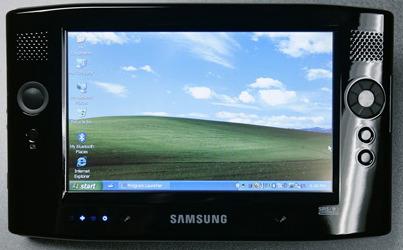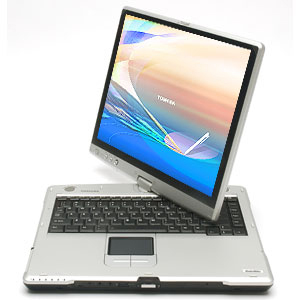Did you opt for a laptop over a tablet when you bought your latest mobile PC? You can’t really be blamed. Tablets tend to offer less performance for the money, and hit the middle or worse overall on key audio benchmarks like processor speed, hard disk, and I/O. But you’ve also missed out: unlike a laptop, a tablet can fit comfortably on a music stand. It’s easier to tote from one part of your studio to another. It’s the perfect way of entering music notation or tweaking soft synths, with instant access to the interface.
So, great news: Microsoft, Intel, and hardware vendors have unveiled the Ultra-Mobile PC. What is it? Exactly the same tablet as before, only smaller, much slower, much less flexible, and only slightly cheaper. Uh — yay? Search on Technorati for all the buzz if you want, but I can sum it up:
It’s a smaller, slower tablet that delivers less value with more tradeoffs. And for music, it’s totally disastrous. Meanwhile, there are fantastic tablet computers that do so much more, at about the same price. Ironically, the UMPC comes just as those tablets have finally matured.
Updated: Two potential items could change my (and maybe your) mind on the new mini-tablets. One is, the price could in fact get closer to $500, which makes my comparison to bigger, more powerful tablets totally moot, and makes them much more appealing as a satellite to your main computer(s). Two, it would be interesting to run Windows Remote Desktop or VNC to remotely control a more powerful computer, or do simple sequencing and soft synths via this tablet, the USB port, and your favorite hardware controller. -PK


Let’s compare: there’s no ship date or pricing yet, but Microsoft says it’ll run “under $1000,” which I’m guessing means $999. By contrast, Toshiba will sell you its Satellite R15 tablet/notebook hybrid for US$1149. (Pictured here. Boy, I actually want it.) It has everything you need to replace your laptop: a QWERTY keyboard, a big screen, USB and FireWire, and even a DVD burner. It’s no powerhouse, but it’ll run Reason soft synths or an Ableton Live set (with an external hard drive, ideally), and it’ll certainly run Sibelius or Finale on a music stand. It even has a swift 1.7G Pentium M, which means it can probably outrun my existing Toshiba notebook workhorse. The new Samsung Q1: think 900 MHz Celeron. 900 MHz, seriously? Yes, okay, the Q1 looks slick (though it reminds me of a portable Sega), and the Toshiba looks clunky. But I’ve used tablets in person, and they’re quite portable and comfortable. Aside from a few touch-friendly extras, these UMPCs even run the same tablet OS! (That’s a good thing, but it furhter suggests that they’re really just downgraded tablets.)
So why would you get a hobbled “Ultra-Mobile PC” that performs like a 4-year-old laptop instead? Battery life is reportedly only 3 hours, and while it is much lighter and smaller than a tablet, it’s not light and small enough to match the form factor of the many excellent Windows Mobile PDAs on the market. I love my Dell Axim X30, for instance. Maybe you’d get the UMPC to play music and video — but at nearly a grand, that makes it yet another silly entertainment toy for the rich, and with everyone blowing money on iPods, Xbox 360s, and the like, that seems wildly unlikely to catch on. Yes, I’m being unfair by looking at this product from the music market, which isn’t Microsoft’s target market. But think about it: the whole point of the PC is that there is no one target market. It’s the flexibility of the device for a broad swath of users. And that makes me look at the UMPC and think about product failures like eMate and Newton rather than product successes like the original Apple PowerBook or iPod. (Boy, uh, it is interesting how Apple managed to create the blockbusters in those categories, huh?)
So why am I bothering even griping about this? Because I think tablet computers could be the missing link in the mobile music studio. And, in fact, looking at the UMPC and checking out the latest tablet specs makes me want to go trade my existing laptop for a tablet right now.
There’s also another possibility that’s missed here: why not have a tablet remote for your desktop computer? It’s not a new idea, but I still haven’t seen it done right. Imagine that instead of a crippled laptop, the tablet served as a dumb terminal for a more powerful desktop form factor PC. It could serve as an additional display, with a headphone jack and touch and stylus input. Your desktop PC (on the desk for consumers or in a rack mount for pros) would do all the heavy lifting, but you could access it from anywhere via the tablet.
There’s reason to believe that desktop enclosures will continue to advance, too. Graphics cards in particular are getting faster by the day, and offering new musical applications with programs like Jitter, as well as some seriously sweet 3D / video eye candy.
The problem is, the UMPC isn’t designed to do this, though you could presumably install Microsoft’s superb Remote Desktop or the open source VNC to do the job, even via a Mac/PC setup. And the UMPC is needlessly pricey for a device that could be a dumb terminal.
So, personally, I think it’s time to entirely throw out Microsoft’s and Intel’s and Samsung’s vision of this, and figure it out for ourselves. I bet we can come up with a much more compelling vision of how to relate to our computers. And hopefully Apple’s recent patent filings for touchscreens mean other manufacturers could get in this game.